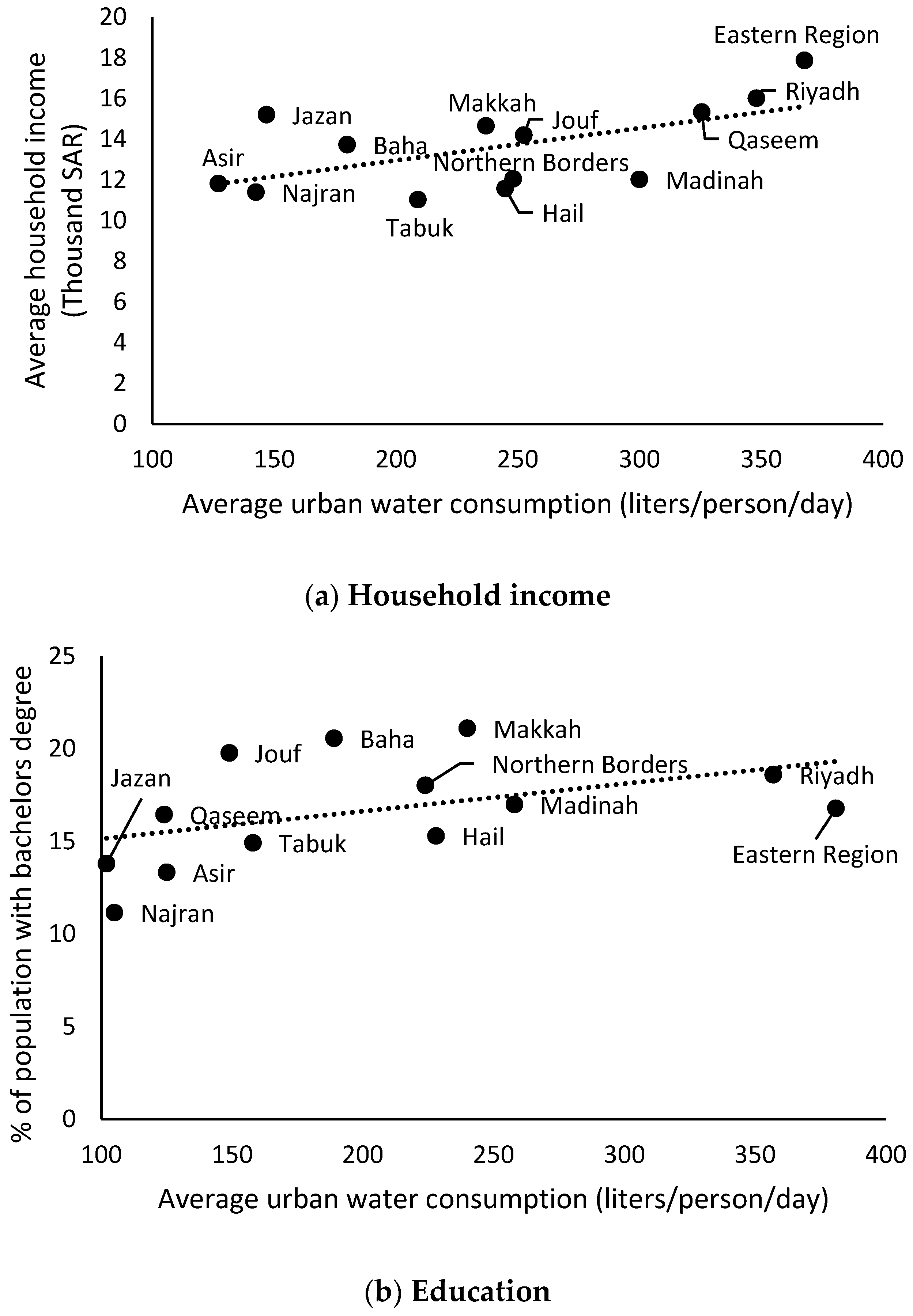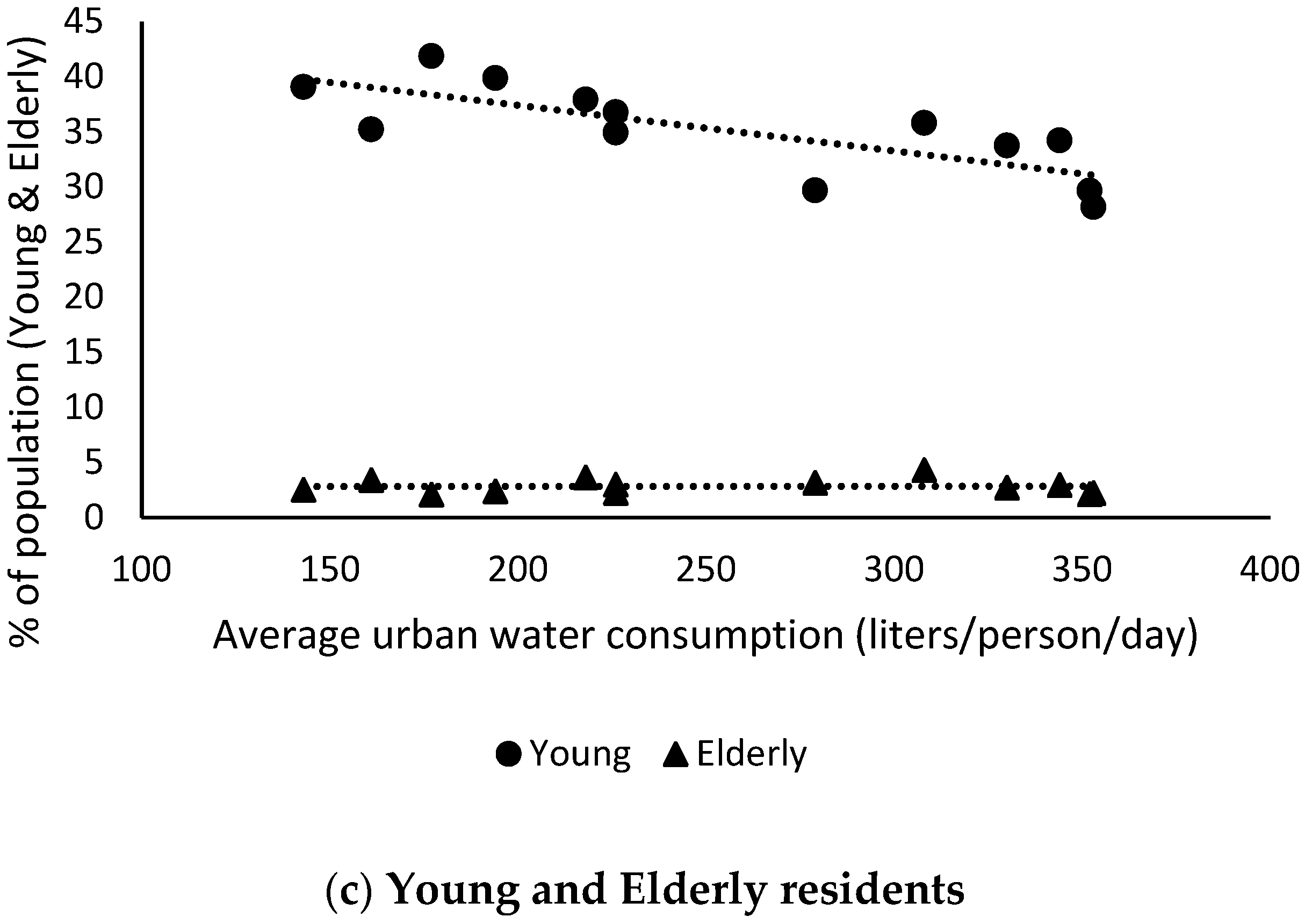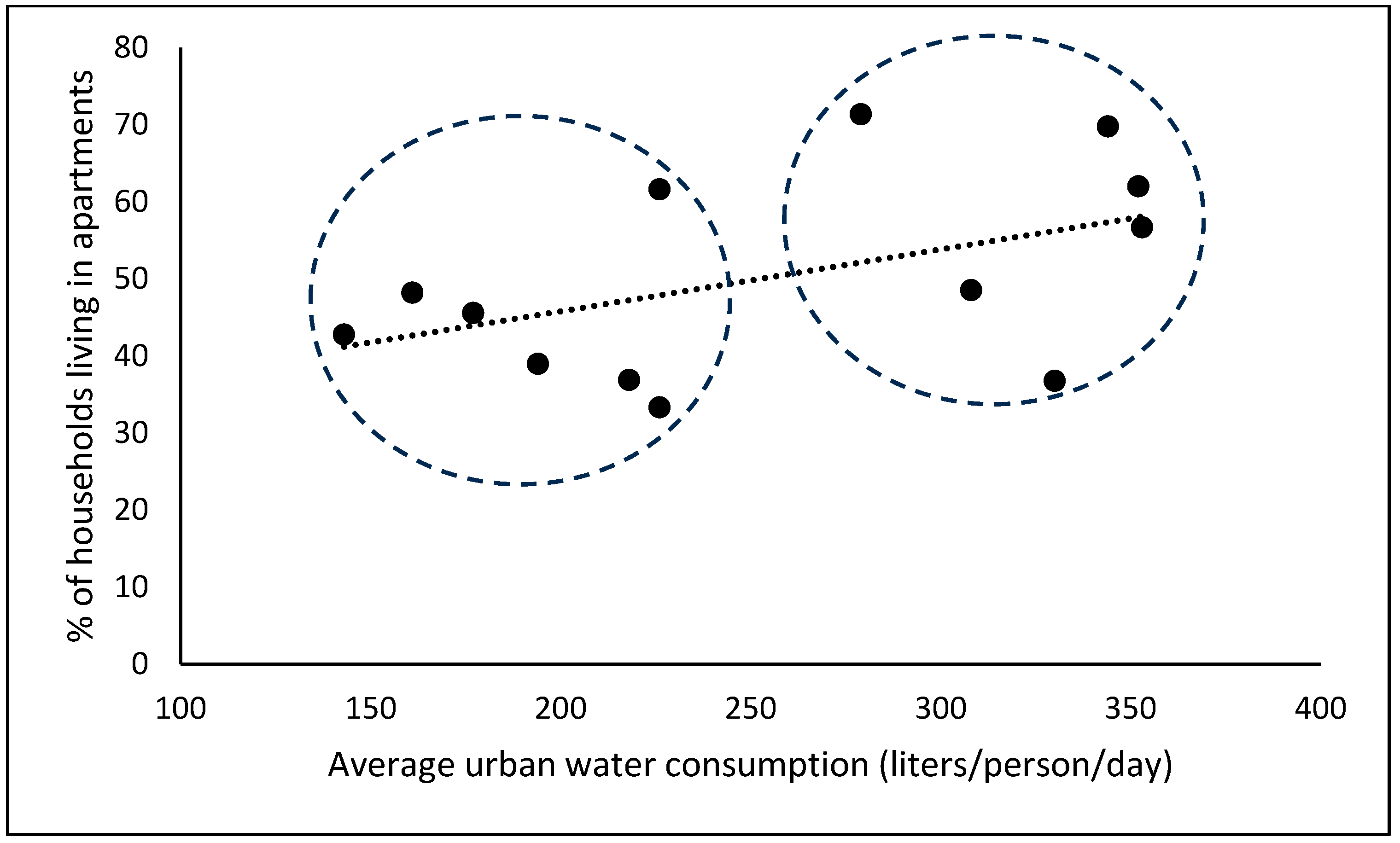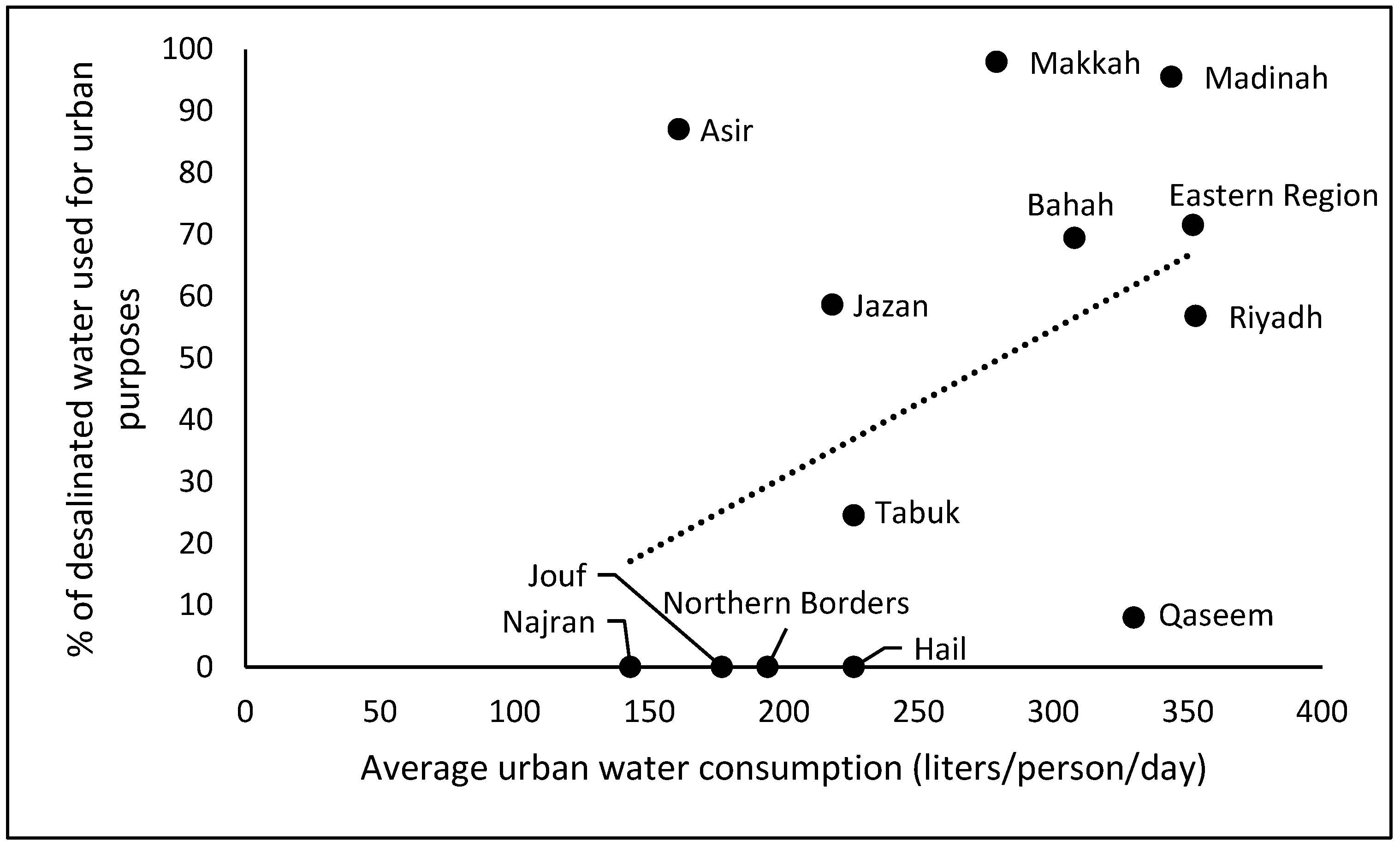1. Introduction
Urban water consumption in Saudi Arabia has increased rapidly over the past several decades, largely due to population increase and fast economic growth [
1]. Total urban water consumption in Saudi Arabia increased from 200 million m
3 in 1970 to 3511 million m
3 in 2022 [
2,
3]. To meet this demand, urban areas in Saudi Arabia relied mainly on desalinated water (68% of the total) and groundwater (30%) [
2]. More than 80% of this demand comes from four administrative regions: Riyadh, Makkah, Eastern Region, and Medina. Despite uniform national water pricing and policies across all 13 administrative regions, stark regional disparities in per capita water use persist. For instance, daily per capita urban water consumption varied from 143.2 L in Najran to 352.7 L in Riyadh in 2022 [
2]. These variations raise critical questions about the underlying drivers of water use and the effectiveness of national strategies in addressing regional differences, particularly in a country characterized by arid conditions and limited freshwater resources.
Historically, Saudi Arabia has relied on substantial government subsidies to ensure water affordability, but in 2016, the Saudi government reduced water subsidies/incentives in an effort to enhance water efficiency and increase government revenues and also introduced several programs to mitigate the effects of the domestic water tariff increase [
4]. The National Water Efficiency and Conservation Center (MAEE) deployed a series of initiatives aimed at rationalization and enhancement of water consumption in all sectors of Saudi Arabia, including the residential sector, through multiple channels, such as the creation of an efficiency program with the coordination and cooperation of different government agencies and awareness campaigns. In order to achieve the aims and targets of these reforms at the best level, Saudi Arabian policymakers may need to better comprehend the regional drivers of urban water consumption.
Urban water consumption is determined by a variety of factors, including economic, demographic, and climatic influences, among others [
5]. Assessments of the drivers of urban water consumption at the national level might not be representative of the different regions with their different characteristics. Previous studies have focused attention on estimating national or city-level water demand models in Saudi Arabia [
1,
6,
7]. For instance, Abu Rizaiza [
6] analyzed water use in Western cities using 1985 data, while Almutaz et al. [
7] projected Riyadh’s desalinated water needs, leaving regional disparities largely unexplored.
This study addresses this gap by leveraging the novelty of a systematic investigation into regional heterogeneity in urban water consumption patterns across all 13 administrative regions of Saudi Arabia. Unlike prior research focused mainly on national or city-level models, our study employs detailed regional-level data from 2010 to 2022, allowing for a more precise assessment of inter-regional differences. Additionally, we incorporate a comprehensive set of variables—spanning socio-demographics, household infrastructure, appliance ownership, water sources, institutional factors, and environmental attitudes—that have rarely been analyzed together in the Saudi context. By highlighting how these factors interact to shape consumption patterns, our findings provide valuable insights for designing region-specific water conservation policies beyond a one-size-fits-all approach. Furthermore, it leverages recent data from diverse sources to offer an up-to-date perspective that reflects the impacts of recent policy reforms and socioeconomic shifts. The remainder of this paper is structured as follows: we first review relevant literature on urban water consumption determinants, then describe our data and methods, present and discuss our findings, and finally, offer conclusions and policy recommendations.
2. Literature Review
The literature on the determinants of urban (i.e., residential) water consumption is large and extensive. Early works on water demand estimation can be traced back to the 1950s [
8]. Most studies in the literature focus on measuring the price elasticity of water demand. A number of studies have reviewed and analyzed the existing literature, such as Dias and Ghisi [
9], Cominola et al. [
10], Corbella and Pujol [
11], Sebri [
12], and Tanverakul and Lee [
13]. Studies in the United States and Europe usually employ household-level data; however, in developing countries, such data are not available, and aggregate data are used instead [
14]. Since the analysis employed in this paper relies on regional data, we limit our review to studies that compare different levels of water consumption across multiple regions (i.e., used aggregate data for urban water consumption).
The term “region” has different meanings across academic disciplines [
15]. Regions can be within the country or cross the country’s borders. Within countries’ regions can also be defined at different levels such as first or principal level (i.e., subnational levels, such as states, provinces, or regions) or can be at smaller governance levels (second- and third-level divisions that include counties, municipalities, cities, villages, etc.).
At the sub-national level, Baigorri et al. [
16] examined the disparities in the regional consumption of household water (liter per inhabitant per day) in Spain. The authors employed convergence analysis and examined the drivers of the convergence in residential water consumption between regions. Using data from 2000 to 2018 for 17 regions, they found that there is no single pattern of behavior across the Spanish regions and that there exist three convergence groups, confirming the regional disparities in water consumption. They also found that household income, birth rate, and spending on environmental protection drive the convergence in each group. Similarly, Acuña et al. [
17] analyzed the convergence of residential water consumption across Chilean localities using econometric methods and data from 348 localities between 2010 and 2015. Their findings suggest that water consumption in Chilean regions is converging, primarily influenced by economic factors and climate variability. The study highlights that higher income, temperature, household size, and the number of bathrooms drive increased water consumption, while higher water prices, increased rainfall, and a greater number of youngsters per household reduce it.
Romano et al. [
18] estimated the determinants of residential water demand (liters per capita per day) for chief towns of every Italian province for the period 2007–2009. They examined multiple factors and found that income and population have a positive and statistically significant impact on residential water consumption, whereas water tariffs, altitude, and precipitation have negative and statistically significant impacts. Similarly, Polycarpou and Zachariadis [
19] estimated the residential water demand in three urban districts in Cyprus using quarterly data for the period 2000–2009. They found that higher water tariffs and service disruptions are negatively associated with lower residential water consumption. On the other hand, income, temperature, and rainfall had positive effects on residential water consumption. Other authors have also examined the determinants of total water consumption, including urban water use, such as Anang et al. [
20] in Malaysia and Long et al. [
21] in China.
At a smaller governance level (i.e., local level), Worland et al. [
22] studied the relationship between municipal water use and 18 covariates in 2500 counties and 83 cities in the United States. They found that the impacts of those covariates are not uniform across the country. Specifically, they found that counties in the Northeast and Northwest climate regions are more sensitive to social variables, whereas counties in the Southwest and East North Central climate regions are more sensitive to environmental variables. For the city model, they found that arid cities with a high cost of living and relatively low water bills sell more water per customer.
City or village-level studies are also widely available. In Saudi Arabia, an older study by Abu Rizaiza [
6] examined the residential water usage in four major cities in the western part of the country (Jeddah, Makkah, Madina, and Taif). Using primary data from 563 questionnaires in 1985, he examined the relationship between socioeconomic and climatological factors on residential water use. It was found that income, temperature, and price of water (for those who rely on water tankers as a source of water) were the most important factors affecting residential water use. At the village level, Keshavarzi et al. [
23] examined the rural domestic water consumption behavior in 33 villages in Iran. They categorized water customers into low, medium, and high consumers. They found that water consumption was significantly correlated with household size, age of household head, garden size, greenhouse size, and garden watering times per month with tap water. Finally, Ismail et al. [
24] compared residential water end-use patterns in 39 major cities in developed and developing countries. They found that there exist six different major trends in household water consumption patterns with main water activities: cooking, bathing, washing machines, faucets, and toilet use. They also identified the drivers for those patterns to be socioeconomic characteristics, physical, spatial, climatic conditions, and political restrictions.
In summary, many studies examined the heterogeneity or disparity of urban water consumption across different spatial units. However, to our knowledge, no study has examined this issue in Saudi Arabia at the regional level. Thus, our objective in this paper is to analyze this issue by examining different factors including factors not included in previous studies such as environmental awareness and institutional factors. This is particularly relevant to Saudi Arabia, where an arid climate, heavy dependence on energy-intensive desalination, and rapid urbanization amplify the urgency of understanding regional differences to ensure sustainable water management.
5. Discussion
This study investigated the factors contributing to regional heterogeneity in urban water consumption across the 13 administrative regions of Saudi Arabia between 2010 and 2022. Our findings reveal significant disparities in per capita water use, with daily per capita consumption varying from as low as 107 L in Najran to as high as 368 L in the Eastern Region. These findings align with previous studies such as Baigorri et al. [
16] and Acuña et al. [
17], who also found substantial regional variations in residential water consumption in Spain and Chile, respectively, and Romano et al. [
18], who emphasized local factors in shaping water use patterns in Italy. The study highlights varying degrees of influence from climatic, socio-demographic, environmental awareness, and property characteristics, mirroring the key determinants found in global studies such as Grafton et al. [
5].
The persistent high water consumption in Riyadh and the Eastern Region, despite uniform national pricing and policies, emphasizes the importance of local factors. These regions, characterized by higher incomes, greater access to public water services, and a prevalence of household appliances associated with increased water use (e.g., washing machines, western toilets), demonstrate the interplay of affluence and convenience in driving consumption patterns. Conversely, lower consumption rates in regions such as Asir, Jazan, and Najran, despite experiencing rapid growth in recent years, suggest that reliance on water tanks as a primary source, coupled with a higher proportion of younger residents and greater awareness of water scarcity, may promote more conservative water use behaviors.
Socioeconomic factors emerge as important determinants of regional water consumption patterns. The positive correlations with household income and education suggest that more affluent and educated regions tend to consume more water, consistent with Romano et al. [
18], Polycarpou and Zachariadis [
19], Long et al. [
21], and Grafton et al. [
5], where higher socioeconomic status often correlates with increased resource use. This presents a particular challenge for Saudi Arabia’s water conservation efforts, as the country continues to experience economic growth and rising education levels. The relationship between the age structure of the population and urban water consumption varies across studies. Some research, such as Nauges and Thomas [
30], indicates a positive correlation between younger populations and higher water consumption, suggesting that young individuals may use water less efficiently (e.g., more frequent baths and laundry). Conversely, studies by Bennett et al. [
31] and Beal et al. [
32] identify a negative correlation, arguing that younger people tend to spend less time at home, leading to lower overall water usage. This evidence highlights that the correlation between age and water consumption may be influenced by factors such as household size and lifestyle.
Property-related factors, such as the prevalence of apartments, also contribute significantly. Higher apartment residency rates in urban centers like Riyadh and the Eastern Region correspond to elevated water consumption, potentially due to water costs being embedded in rental agreements, leading to reduced individual cost sensitivity (i.e., the marginal cost of water is equal to zero). The reliance on water tanks in regions with limited public water access appears to curb consumption, echoing observations in other arid areas [
22]. This is primarily due to limited storage capacity and higher perceived costs. Households that depend on water tanks must carefully manage their usage, as refilling the tanks often requires additional effort and expenses. Unlike a continuous public water supply, which allows unrestricted access, tank users tend to ration water more efficiently to avoid frequent refills. The strong positive correlation between public water service access and consumption suggests that infrastructure availability significantly influences usage patterns. This finding is particularly relevant for policymakers as it indicates that improving water infrastructure access should be accompanied by appropriate conservation measures. The relationship between water source and consumption also aligns with Abu Rizaiza’s [
6] findings in western Saudi Arabian cities, though our study provides a more comprehensive national perspective. Moreover, the presence of certain household appliances, particularly washing machines and western toilets, shows strong positive correlations with water consumption. This resonates with Keshavarzi et al. [
23] findings regarding the impact of household characteristics on water use. As Saudi Arabia continues to modernize, the proliferation of such appliances may further increase water demand unless offset by efficiency improvements. The influence of climatic and geographic factors, while present, appears less pronounced than socioeconomic and property-related variables. While higher temperatures correlate with increased water use, the modest range of temperature variation across regions and the prevalence of indoor climate control systems likely attenuate this effect. The inverse relationships between precipitation, elevation, and water consumption may be indirect, reflecting regional differences in water availability and access to public water infrastructure. Regions with higher elevations or lower rainfall may experience more limited access to public water, incentivizing more frugal consumption. These findings contrast with studies like Polycarpou and Zachariadis [
19] and Acuña et al. [
17] who found strong climate effects and emphasized climate as a primary driver. This suggests that in Saudi Arabia, property and socioeconomic factors may play a more dominant role in determining regional water consumption patterns than climate variations. However, climate change could intensify water scarcity and alter future consumption trends in the coming decades. Rising temperatures may increase evaporation rates, further depleting groundwater reserves already strained by limited precipitation, while changing rainfall patterns could reduce recharge in regions like Asir, heightening reliance on energy-intensive desalination. These shifts may elevate water demand, particularly in urbanizing, high-consumption areas, underscoring the need for adaptive, region-specific policies. Environmental awareness shows a complex relationship with consumption patterns. While environmental interest shows a negative correlation with water use, the relationship between environmental concern and consumption is less clear. This suggests that general environmental awareness may not be sufficient to reduce water consumption without a specific focus on water conservation behaviors, similar to findings by Ismail et al. [
24]. While a significant proportion of residents recognize water scarcity as an important issue, this awareness does not consistently translate into lower consumption, and the presence of water conservation equipment does not necessarily translate into reduced use. This may be due to the “rebound effect,” where increased efficiency from water-saving appliances is offset by increased consumption in other areas (e.g., increased garden watering) or a lack of perceived economic incentive due to subsidized water pricing. This contradiction has been noted in other contexts, such as Sebri’s [
12] work on conservation adoption in North Africa, where behavioral patterns often undermine the intended efficiency of conservation measures.
Water supply in Saudi Arabia is heavily reliant on desalination and groundwater extraction, both of which are institutionally managed at the national level. The reliance on desalination varies across regions, influencing local water consumption patterns. Regions with greater access to desalinated water, such as the Eastern Region, tend to exhibit higher per capita consumption. The expansion of desalination infrastructure and the adoption of water reuse technologies could significantly reshape future water consumption trends. Urbanization also contributes to increased water demand through commercial and industrial activities, greater residential density, and evolving lifestyle patterns. Comparing city sizes, urbanized regions like Riyadh exhibit significantly higher per capita use than smaller, less urbanized areas like Najran, suggesting urbanization levels amplify regional differences through greater public water access and socioeconomic demands, though further city-level data are needed to confirm this trend. As Saudi Arabia continues to experience rapid urban growth, particularly in major metropolitan areas, the strain on water resources is expected to intensify. Policymakers must consider how ongoing urban expansion may further widen regional disparities in water use and develop adaptive strategies that promote efficiency in high-demand areas while ensuring equitable access in smaller cities and rural regions.
In addition to analyses of water demand, recent advancements in optimization techniques have been explored to improve urban water allocation. For instance, Zhang et al. [
33] proposed a graph theory-based approach to optimize water quantity allocation in multi-source urban water supply systems. Given the significant disparities in urban water consumption across Saudi Arabia, integrating such optimization models could provide a data-driven framework for balancing supply and demand, particularly in high-consumption regions like Riyadh and the Eastern Region.
Limitations of this study include reliance on aggregate regional data, which obscures household-level variations in water use and limits the ability to control individual preferences and behaviors. Furthermore, data constraints restricted the analysis of several potentially important variables to a single year. This limits our ability to observe trends and changes between the variables and urban water consumption over time. Additionally, this constraint prevents us from utilizing more advanced statistical techniques, such as regression analysis, to thoroughly explore the relationships due to the lack of longitudinal data. Future research should prioritize the collection of more granular, longitudinal data to enable more rigorous econometric analysis and to examine the dynamics of water consumption patterns over time. Developing more sophisticated models that integrate spatial econometrics to account for interconnected regional water systems and incorporate household-level data could further enhance these insights. Also, research into the effectiveness of different conservation measures across regions with varying characteristics could help optimize policy interventions. Finally, future studies should assess how income inequality affects water affordability and access within each region. By bridging the gap between research and practice, we can promote more sustainable and equitable water management practices in Saudi Arabia and other arid regions facing similar challenges.
Overall, this study contributes to the literature by offering a comprehensive regional analysis of water consumption drivers in Saudi Arabia, an area previously unexplored at this scale. It provides novel insights into the regional heterogeneity of urban water consumption across Saudi Arabia. First, the substantial variation in per capita water consumption across regions, despite uniform national pricing policies, indicates that local context plays a crucial role in determining water use patterns. Second, the primacy of property and socioeconomic factors over climatic conditions suggests that future water demand will be largely shaped by development patterns and lifestyle changes rather than environmental conditions, necessitating proactive planning and adaptive strategies. Third, the inverse relationship between young population demographics and water consumption presents an opportunity for long-term water conservation through targeted education and awareness programs. Fourth, the weak relationship between environmental awareness and actual consumption indicates a gap between environmental knowledge and behavior that needs to be addressed through more effective conservation programs.
















